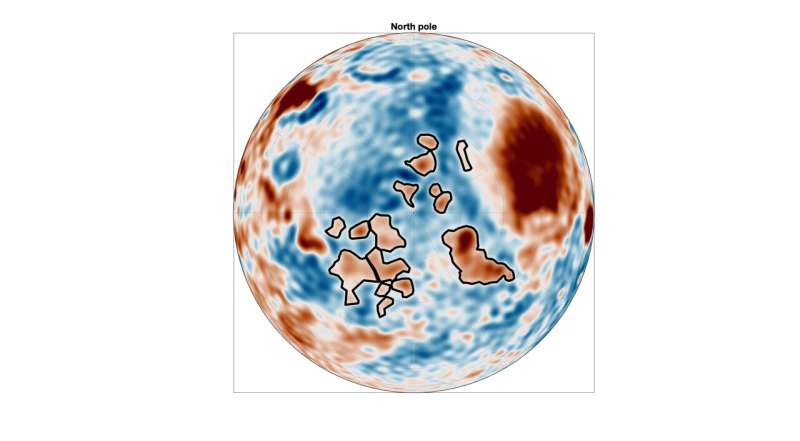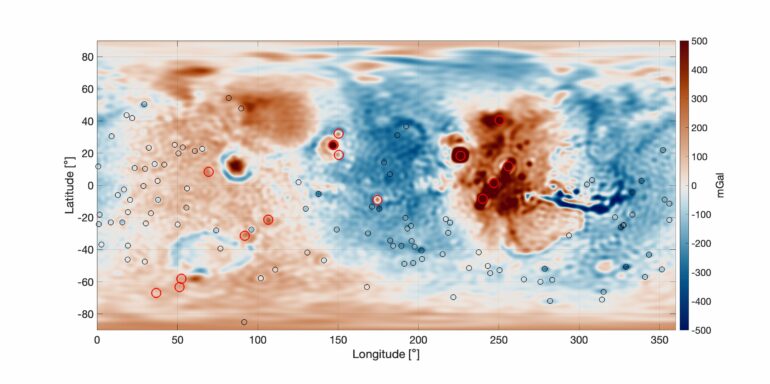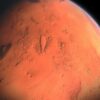Studies of gravity variations at Mars have revealed dense, large-scale structures hidden beneath the sediment layers of a lost ocean. The analysis, which combines models and data from multiple missions, also shows that active processes in the Martian mantle may be giving a boost to the largest volcano in the solar system, Olympus Mons. The findings have been presented this week at the Europlanet Science Congress (EPSC) in Berlin by Bart Root of Delft University of Technology (TU Delft).
Mars has many hidden structures, such as ice deposits, but the features discovered in the northern polar plains are a mystery because they are covered with a thick and smooth sediment layer believed to be deposited on the ancient seabed.
“These dense structures could be volcanic in origin or could be compacted material due to ancient impacts. There are around 20 features of varying sizes that we have identified dotted around the area surrounding the north polar cap—one of which resembles the shape of a dog,” said Dr. Root. “There seems to be no trace of them at the surface. However, through gravity data, we have a tantalizing glimpse into the older history of the northern hemisphere of Mars.”
Dr. Root and colleagues from TU Delft and Utrecht University used tiny deviations in the orbits of satellites to investigate the gravity field of Mars and find clues about the planet’s internal mass distribution. This data was fed into models that use new observations from NASA’s Insight mission on the thickness and flexibility of the Martian crust, as well as the dynamics of the planet’s mantle and deep interior, to create a global density map of Mars.

Map highlighting the dense gravitational structures in the northern hemisphere. The regions denoted by the black lines are high mass anomalies that do not show any correlation with geology and topography. These hidden subsurface structures are covered by sediments from an old ocean. Their origin is still a mystery and a dedicated gravity mission, like MaQuIs, is needed to reveal their nature. © Root et al.
The density map shows that the northern polar features are approximately 300–400 kg/m3 denser than their surroundings. However, the study has also revealed new insights into the structures underlying the huge volcanic region of Tharsis Rise, which includes the colossal volcano, Olympus Mons.
Although volcanoes are very dense, the Tharsis area is much higher than the average surface of Mars, and is ringed by a region of comparatively weak gravity. This gravity anomaly is hard to explain by looking at differences in the Martian crust and upper mantle alone. The study by Dr. Root and his team suggests that a light mass around 1750 kilometers across and at a depth of 1100 kilometers is giving the entire Tharsis region a boost upwards. This could be explained by huge plume of lava, deep within the Martian interior, traveling up towards the surface.
“The NASA InSight mission has given us vital new information about the hard outer layer of Mars. This means we need to rethink how we understand the support for the Olympus Mons volcano and its surroundings,” said Dr. Root. “It shows that Mars might still have active movements happening inside it, affecting and possibly making new volcanic features on the surface.”
Dr. Root is part of the team proposing the Martian Quantum Gravity (MaQuls) mission, which aims to use technology developed for missions like GRAIL and GRACE on the moon and Earth respectively to map in detail the gravity field of Mars.
“Observations with MaQuIs would enable us to better explore the subsurface of Mars. This would help us to find out more about these mysterious hidden features and study ongoing mantle convection, as well as understand dynamic surface processes like atmospheric seasonal changes and the detection of ground water reservoirs,” said Dr. Lisa Wörner of DLR, who presented on the MaQuIs mission at EPSC2024 this week.
More information:
Bart Root et al, Exploration of high mass subsurface structures in the northern hemisphere with joint flexure and mantle convection modelling of the Martian gravity field EPSC Abstracts (2024). DOI: 10.5194/epsc2024-730
Lisa Woerner, Quantum Technologies for Planetary Geodesy, EPSC Abstracts (2024). DOI: 10.5194/epsc2024-632
Provided by
Delft University of Technology
Citation:
Gravity study gives insights into hidden features beneath lost ocean of Mars and rising Olympus Mons (2024, September 13)



